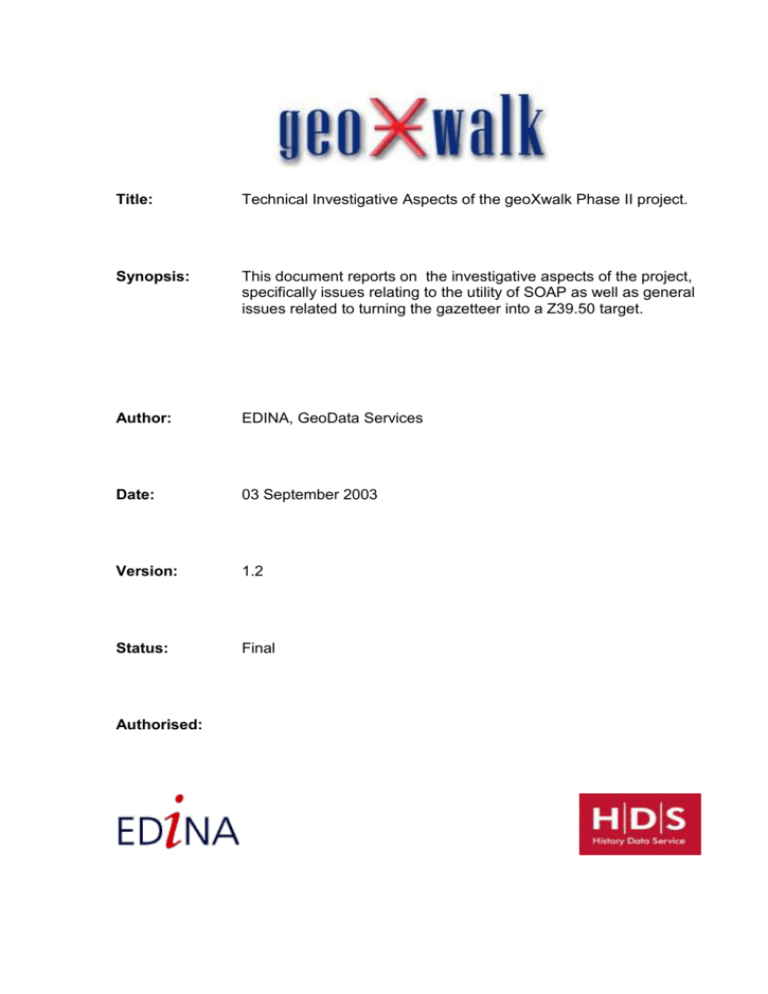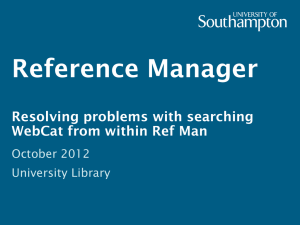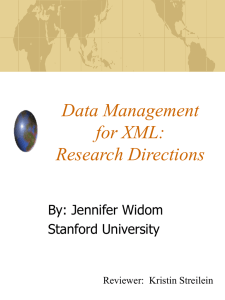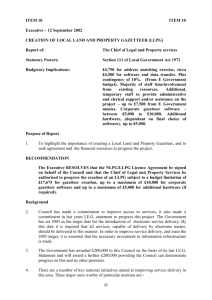Technical Issues Report
advertisement

Title: Technical Investigative Aspects of the geoXwalk Phase II project. Synopsis: This document reports on the investigative aspects of the project, specifically issues relating to the utility of SOAP as well as general issues related to turning the gazetteer into a Z39.50 target. Author: EDINA, GeoData Services Date: 03 September 2003 Version: 1.2 Status: Final Authorised: Contents 1. Introduction 2 2. Project Aims 4 3. SOAP Experiments 4 4. Turning geoXwalk into a Z39.50 Target 5 5. Conclusions & Recommendations 6 Appendix I – Examples of XML Query fragments 8 1 1. Introduction 1.1 Project Aims – geoXwalk Phase II geoXwalk (Phase II) was a one year JISC funded project undertaken by EDINA, University of Edinburgh and the History Data Service, University of Essex investigating the development of a digital gazetteer service and server to provide a machine2machine ‘shared service’ facility to underpin geographic searching within the JISC Information Environment. The central aims of the project were: To develop a demonstrator geo-spatial gazetteer service suitable for extension to full service To consider how the gazetteer data could be made available as a shared service as part of the JISC Information Environment Promote the possibilities of a fully functioning service and act as a proof of concept 1.2 Purpose of document The purpose of this document is to report on investigative aspects of the project, specifically issues relating to the utility of SOAP as well as general issues related to turning the gazetteer into a Z39.50 target. Note that issues related to the use of the Alexandria Digital Library Content Standard, Feature Type Thesaurus and data loading & processing issues are covered separately in related documents (see section 1.7 below). 1.3 Summary The investigations showed that 1.4 Target audience This document is intended for those interested in the geoXwalk project including: People invited to the geo-spatial projects workshop on 29th January 2003 JISC Geo-spatial Working Group JCEI Committee IE Office JISC Secretariat JISC data centres and services, in particular, project associated partners External organisations including the British Library, Ordnance Survey, SCRAN, Scottish Place name Society 2 1.5 Status This document is the final version. 1.6 Change summary Version Date Author Notes 1.0 12/08/2003 EDINA First cut 1.1 28/08/2003 EDINA Minor changes to correct inconsistencies and inclusion of Z39.50 1.2 03/09/2003 EDINA Final corrections 1.7 Related documents Title Alexandria Digital Library Feature Type Thesaurus (ADLFTT) Recommended deletions and extensions for use with Ordnance Survey Data Alexandria Digital Library Content Standard and Data Loading & Processing Issues Report. geoXwalk Evaluation Report 1.8 Author EDINA Date 12 /07/2003 Version 1.2 EDINA 28 /08/2003 1.2 HDS 25/08/2003 1.2 Distribution Open. 1.9 Contact details Dr David Medyckyj-Scott James Reid EDINA Data Library Main Library Building University of Edinburgh George Square Edinburgh EH8 9LJ E-mail: d.medyckyj-scott@ed.ac.uk Tel: +44 (0)131 651 1308 EDINA Data Library Main Library Building University of Edinburgh George Square Edinburgh EH8 9LJ E-mail: james.reid@ed.ac.uk Tel: +44 (0)131 651 1383 3 2. Project Aims One of the objectives of the geoXwalk Phase II project was to investigate issues related to using Simple Object Access Protocol (SOAP) mechanisms as a means to access the gazetteer and also to investigate the potential of turning geoXwalk into a Z39.50 target. These investigative aspects of the project were secondary to developing network addressable middleware which could support querying of a gazetteer by a range of clients from other JISC services. Increasingly, this type of functionality is achieved by exposing the middleware components as web services. A web service runs over internet transport protocols (usually HTTP) and delivers data, typically in XML format, to some software client. SOAP is a lightweight XML-based messaging protocol which is frequently used in web services (to the extent that in some quarters it is thought they are synonymous) though this is a misnomer. More traditionally, remote querying of databases (especially bibliographic databases), has been mediated through adoption of the Z39.50 protocol which has evolved from the requirements of the digital library community. As was noted in the Phase I reports, there are limitations in this protocol to the types of geographical query that can be supported in practice but we have written software that does turn geoXwalk into a Z-target and this is reported more fully below. 3. SOAP Experiments Initially we developed a java-based web service using SOAP. The aim was to expose a small set of the geoXwalk functionality in a proof of concept exercise. The service developed supports two-way translations between place names and minimum bounding rectangles (expressed in national grid or longitude / latitude). A java client was developed to test this service and once we were satisfied that the service operated correctly we set out to develop a Perl client to use the service in the Go-Geo! geo-data portal. One of the perceived advantages of SOAP is that as communication between client and server is in XML it should (in theory) be straightforward to achieve interoperability between different programming languages and environments To this end the geoXwalk middleware, developed in Java and the Go-Geo! Perl based environment, formed a relatively heterogeneous and realistic cross-language test environment. In theory a client only needs to have the capability to produce and consume well-formed XML over a standard transport protocol (usually HTTP) and it should be irrelevant to the service how this is actually achieved. We did however run into some issues when we tested this by developing a Perl client for Go-Geo!. At what was then an early stage in the development of the SOAP specification, different implementations of SOAP did have some incompatibilities. Although the problems thrown up were tractable and we did 4 develop a working Perl client it was clear that adding a SOAP layer around the XML request/response had potential to add development overhead. As our goal was to make development of clients as simple as possible this represented a significant disadvantage. Two protocols for querying the gazetteer (in addition to Z39.50) were identified: The Alexandria Digital Library Gazetteer Protocol and the Open GIS Consortiums Filter Encoding Specification. The first of these has been implemented and is referred to more fully in the ‘Alexandria Digital Library Content Standard and Data Loading & Processing Issues’ Report. The latter, which supports richer spatial and aspatial querying is attendantly more complex and has consequently only been preliminarily investigated but will be more fully supported in Phase III of the project. Both these are XML-based protocols without a SOAP component. In developing the full demonstrator service we opted for initially implementing the ADL Query Protocol. The advantages of this were: - the protocol is relatively well known within the wider geo-community and is emerging as a potential de facto standard; it has the benefits of using XML over HTTP without the need to add the costs of SOAP development; we are not convinced that a SOAP implementation (at this time) offers significant advantages over a straight XML over HTTP approach; XML over HTTP captures the core features of a SOAP-based approach so we could evolve to a SOAP service as/if SOAP was more widely adopted within the JISC IE architecture. Consequently, while we still have demonstrator SOAP clients, we favour the deployment of XML over HTTP based clients. Examples of the XML requests that a client would issue to perform various types of search are included in Appendix I. 4. Turning geoXwalk into a Z39.50 Target As was mentioned in the Phase I documentation for geoXwalk and is more fully documented in the Phase I reports for the sister project, Go-Geo! (www.gogeo.ac.uk), there are no Z39.50 implementations currently available which will allow anything more complicated than bounding rectangles to be specified as a search criterion and these are limited to simple ‘overlaps’ spatial operators neglecting ‘within’ and ‘contains’ type operations. We therefore recommended adoption of some other protocol for querying than Z39.50. However, as part of the Phase II project the potential for turning geoXwalk into a Z39.50 target was an explicit investigative objective stipulated by JISC. To that end a Z39.50 interface was built that acts as a wrapper on the existing XML over HTTP based geoXwalk interface (i.e. the ADL Query Protocol). The implementation accepts a small range of Z39.50 attributes that correspond directly to the services offered, and turns this input into an xml document 5 which is passed to the existing service over HTTP as an ADL Query Protocol query. The returned result set (an XML document that represents a series of ADL ‘standard’ reports on the the features meeting the query criterion) is parsed to form a number of separate xml result documents that are cached in process memory in order to be fetched by the Z39.50 clients. Listed below are the Z39.50 Attributes corresponding to the XML query inputs which relate to the five query types that the ADL Query Protocol supports – see ‘Alexandria Digital Library Content Standard and Data Loading & Processing Issues Report’. 1. Name input: GEO Attribute-set 2042, Place Keyword 2. Pattern name input: Bib1 Attribute-set 4, Title 3. Identifier input: Bib1 Attribute-set 1032, Doc-id 4. Feature type input: GEO 2002, Theme Keyword 5. Bounding box input: GEO 2060, Bounding Co-ordinates Note that the pattern name and identifier inputs are mapped to common sense Z attributes for purposes of convenience. Our investigations suggest that the system appears to work as required, offering a Z39.50 interface to all the functionality of the geoXwalk service as exposed through the ADL Query Protocol. Limited testing to date suggests that performance is no worse than via the existing XML service, and does not appear to add significant overhead. 5. Conclusions & Recommendations Investigations into the use of SOAP and Z39.50 for accessing the gazetteer suggest that while this is achievable in practice there may be legitimate reservations as to the advisability of doing so. We appreciate that given the pervasiveness of Z39.50 within the JISC IE it is tempting to conclude that Z offers a useful protocol for the gazetteer service to adopt as its primary one. However, it is worth setting this within the evolving context of web services and also bearing in mind that the Z implementation as it stands is acting as a wrapper to the XML over HTTP route. In the medium to longer term, support for richer query protocols like the OGC Filter Encoding Specification would militate against premature adoption of Z and, objectively, adoption of an explicitly designed protocol for geographical querying makes more sense than ‘massaging’ an existing sub-optimal one. That said, we can support Z although this may require some transparency of the mappings from a clients perspective in order for adoption to become widespread. 6 Recommendations From our experiences investigating SOAP and Z39.50, we would currently recommend: a straight XML over HTP route for querying the geoXwalk gazetteer; employing the ADL Query Protocol with richer querying being supported by a migration / co-adoption of the OGC Filter Encoding Specification. 7 Appendix I – Examples of XML Query fragments 1. Simple Name Query: ‘Name = Kent’ <?xml version="1.0" encoding="UTF-8"?> <gazetteer-service xmlns="http://www.alexandria.ucsb.edu/gazetteer" version="1.1"> <query-request> <gazetteer-query> <name-query operator="equals" text="Kent"/> </gazetteer-query> <report-format>standard</report-format> </query-request> </gazetteer-service> 2. Spatial query by feature type and bounding box: ‘Towns within Essex’ <?xml version="1.0" encoding="UTF-8"?> <gazetteer-service xmlns="http://www.alexandria.ucsb.edu/gazetteer" xmlns:gml="http://www.opengis.net/gml" version="1.1"> <query-request> <gazetteer-query> <and> <class-query thesaurus="Edina Feature Type Thesaurus" term="towns"/> <footprint-query operator="within"> <gml:Box> <gml:coordinates>-0.02988,51.45753, 1.30798,52.07042</gml:coordinates> </gml:Box> </footprint-query> </and> </gazetteer-query> <report-format>standard</report-format> </query-request> </gazetteer-service> 8 3. Pattern matched name: ‘Name like Aberdour’ <?xml version="1.0" encoding="UTF-8"?> <gazetteer-service xmlns="http://www.alexandria.ucsb.edu/gazetteer" version="1.1"> <query-request> <gazetteer-query> <name-query operator="matches-pattern" text="aberdour"/> </gazetteer-query> <report-format>standard</report-format> </query-request> </gazetteer-service> 4. Identifier request: ‘Unique ID = 281196’ (note that this can be used to return a geometry to be used for request chaining to support complex spatial querying – see query 9 below) <?xml version="1.0" encoding="UTF-8"?> <gazetteer-service xmlns="http://www.alexandria.ucsb.edu/gazetteer" version="1.1"> <query-request> <gazetteer-query> <identifier-query identifier="281196" /> </gazetteer-query> <report-format>standard</report-format> </query-request> </gazetteer-service> 9 5. Name and feature type : ’Aberdour admin parish’ <?xml version="1.0" encoding="UTF-8"?> <gazetteer-service xmlns="http://www.alexandria.ucsb.edu/gazetteer" version="1.1"> <query-request> <gazetteer-query> <and> <name-query operator="equals" text="aberdour"/> <class-query thesaurus="Edina Feature Type Thesaurus" term="parish admin"/> </and> </gazetteer-query> <report-format>standard</report-format> </query-request> </gazetteer-service> 6. Feature type : ‘All features of type district admin’ <?xml version="1.0" encoding="UTF-8"?> <gazetteer-service xmlns="http://www.alexandria.ucsb.edu/gazetteer" version="1.1"> <query-request> <gazetteer-query> <class-query thesaurus="Edina Feature Type Thesaurus" term="district admin"/> </gazetteer-query> <report-format>standard</report-format> </query-request> </gazetteer-service> 10 7. Spatial query by name and bounding box : ‘Features named Aberdour within Fife’ <?xml version="1.0" encoding="UTF-8"?> <gazetteer-service xmlns="http://www.alexandria.ucsb.edu/gazetteer" xmlns:gml="http://www.opengis.net/gml" version="1.1"> <query-request> <gazetteer-query> <and> <name-query operator="equals" text="aberdour"/> <footprint-query operator="within"> <gml:Box> <gml:coordinates>-3.379,56.023, -3.125,56.097</gml:coordinates> </gml:Box> </footprint-query> </and> </gazetteer-query> <report-format>standard</report-format> </query-request> </gazetteer-service> 8. Spatial query by feature type and bounding box : ‘Parishes within Fife’ <?xml version="1.0" encoding="UTF-8"?> <gazetteer-service xmlns="http://www.alexandria.ucsb.edu/gazetteer" xmlns:gml="http://www.opengis.net/gml" version="1.1"> <query-request> <gazetteer-query> <and> <class-query thesaurus="Edina Feature Type Thesaurus" term="parish admin"/> <footprint-query operator="within"> <gml:Box> <gml:coordinates>-3.374,56.001, -2.546,56.445</gml:coordinates> </gml:Box> </footprint-query> </and> </gazetteer-query> <report-format>standard</report-format> </query-request> </gazetteer-service> 11 9. Spatial Query by Name and Identifier: ‘Features with name Aberdour within the geometry of feature with ID 281196’ <?xml version="1.0" encoding="UTF-8"?> <gazetteer-service xmlns="http://www.alexandria.ucsb.edu/gazetteer" version="1.1"> <query-request> <gazetteer-query> <and> <name-query operator="equals" text="aberdour"/> <footprint-query operator="within"> <identifier>281196</identifier> </footprint-query> </and> </gazetteer-query> <report-format>standard</report-format> </query-request> </gazetteer-service> 12






